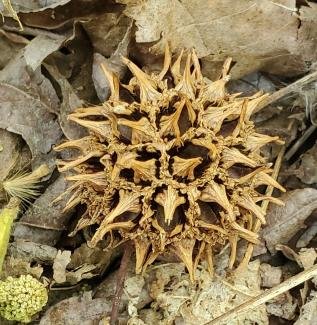
Habitat: Tidal and non-tidal swamp forests, depression ponds and swamps, wet flatwoods, floodplain forests, mesic and dry-mesic upland forests, and old fields; most abundant in and characteristic of disturbed and early-successional vegetation.
Wildlife value: Supports Imperial Moth and Hickory Horndevil (Citheronia regalis) larvae. Songbirds, like the American goldfinch eat the seeds during the winter and birds probe inside fruits in winter for invertebrates. Beavers, mice and rabbits eat the bark.
Notes: One of the most durable and best performing native trees. Stunning fall color. Needs a large area for root development. The prickly gumballs might be unwelcome on a sidewalk or where people run around barefoot. 'Rotundiloba' variety does not produce gumballs.
Carniola Farms Nursery
Nursery operates Arlington Native Plants & Edibles located at 925 N. Madison St. Arlington Virginia 22205. Plants can be purchased at any time by making an email appointment at carniolafarms@gmail.com. Also, during the during the planting season, they are open some Saturdays from 11AM to 3PM. Check their website for datesThis plant list is from the beginning of the 2025 season and may be out-of-date
| In Stock? | Notes | ||
|---|---|---|---|
| Yes | View My Wishlist |
Bona Terra Nursery
Small family-run native plant nursery with a focus on the local genetics necessary to restore diversity in the Chesapeake eco-region. Offers free remote design service for small gardens up to 400 square feet. Orders are placed via email and items can be picked up at their NW DC office or delivered for a fee. This plant list is from the beginning of the 2025 season and may be out-of-date
| Pots Available | Pot Size | Notes | Add to Wishlist | |
|---|---|---|---|---|
| 6 | 3 Gallon | View My Wishlist |

